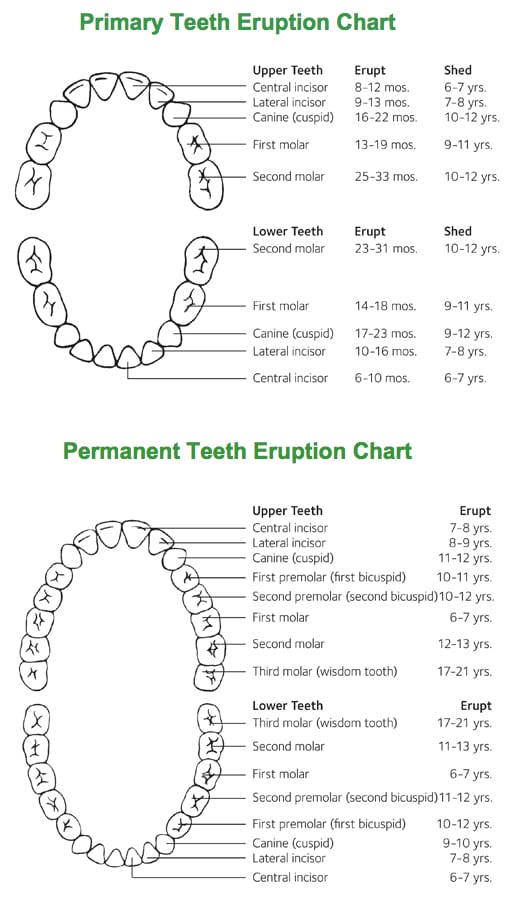
Teaching your child good oral hygiene habits early can lead to a lifelong healthy smile, but did you know that just because babies don’t have any visible teeth doesn’t mean they can’t get cavities? A baby’s 20 primary teeth are already present in the jaws at birth. And those baby teeth that begin coming through the gums around 6 months help set the stage for future smiles by keeping space in the jaw for adult teeth. When a baby tooth is lost too early, the permanent teeth can drift into the empty space and make it difficult for other adult teeth to find room when they come in. At this point, you can either get a Wisdom teeth removal done, or just wait until they come off themselves. This can make teeth crooked or crowded. That’s why starting infants off with good oral care can help protect their teeth for decades to come.
Baby Bottle Tooth Decay
You can help prevent your baby from getting cavities or developing what is called Baby Bottle Tooth Decay by beginning an oral hygiene routine within the first few days after birth. Start by cleaning your baby’s mouth by wiping the gums with a clean gauze pad. This helps removes plaque that can harm erupting teeth. When your child’s teeth begin to come in, brush them gently with a child’s size toothbrush and water. For bottle feedings, place only formula, milk, or breast milk inside and avoid using sugary beverages such as juice or soda. Infants should finish their bedtime and naptime bottle before going to bed.
Nutrition and Tooth Health
Children need strong, healthy teeth to chew their food, speak and have a good-looking smile. What’s more, a good diet is essential for a child’s growth and development. Almost all foods, including milk or vegetables, have some type of sugar, which can contribute to tooth decay. To help control the amount of sugar your child consumes, always try to read food labels and choose foods and beverages that are low in added sugars. Also, select beverages, such as water, that hydrate and contribute to good nutrition. In addition, bottles and pacifiers also impact your child’s oral health. Here are some tips to keep your child’s mouth healthy:
Read Next | Getting Kids to Brush Their Teeth
Your Child’s First Dental Visit
As soon as your child’s first tooth appears, it’s time to schedule a dental visit. The ADA recommends that the first dental visit take place within six months after the first tooth appears, but no later than a child’s first birthday. Don’t wait for them to start school or until there’s an emergency. Get your child comfortable today with good mouth healthy habits. Talk to an emergency dentist right away in case of extreme pain or any other serious dental concern.
Although the first visit is mainly for the dentist to examine your child’s mouth and to check growth and development, it’s also about your child being comfortable. To make the visit positive:
- Consider making a morning appointment when children tend to be rested and cooperative.
- Keep any anxiety or concerns you have to yourself. Children can pick up on your emotions, so emphasize the positive.
- Never use a dental visit as a punishment or threat.
- Never bribe your child.
- Talk with your child about visiting the dentist.
During this visit, you can expect the dentist to:
- Inspect for oral injuries, cavities, or other problems.
- Let you know if your child is at risk of developing tooth decay.
- Clean your child’s teeth and provide tips for daily care.
- Discuss teething, assimilate teething symptoms, pacifier use, or finger/thumb sucking habits.
- Discuss treatment, if needed, and schedule the next check-up.

Dealing with Dental Emergencies
Accidents can happen anywhere, anytime. Knowing how to handle a dental emergency can mean the difference between saving and losing your child’s permanent tooth. For all dental emergencies, it’s important to take your child to the dentist or an emergency room as soon as possible. Here are some tips if your child experiences a common dental emergency:
- For a knocked-out tooth, keep it moist at all times. If you can, try placing the tooth back in the socket without touching the root. If that’s not possible, place it in between your child’s cheek and gum, or in milk. Call your dentist right away.
- For a cracked tooth, immediately rinse the mouth with warm water to clean the area. Put cold compresses on the face to keep any swelling down.
- If your child bites his tongue or lip, clean the area gently and apply a cold compress.
- For toothaches, rinse the mouth with warm water to clean it out. Gently use dental floss to remove any food caught between the teeth. Do not put aspirin on the aching tooth or gum tissues.
- For objects stuck in the mouth, try to gently remove with floss but do not try to remove it with sharp or pointed instruments.
You can help prevent tooth decay by following these tips:
- Brush twice a day with a fluoride toothpaste.
- Clean between your teeth daily with floss or interdental cleaner.
- Eat nutritious and balanced meals and limit snacking.
- Check with your dentist about the use of supplemental fluoride, and/or dental sealants
- Visit your dentist regularly for professional cleanings and oral examination (read more here).
As long as you made sure your teeth are in good condition, you can try cosmetic dentistry. Learn more how you can get a brighter, straighter, and more aesthetically pleasing smile.
Provided by the American Dental Association’s (ADA) award-winning website for oral-health information, MouthHealthy.org.

Read Next | Where to Find a Great Dentist in Staten Island







